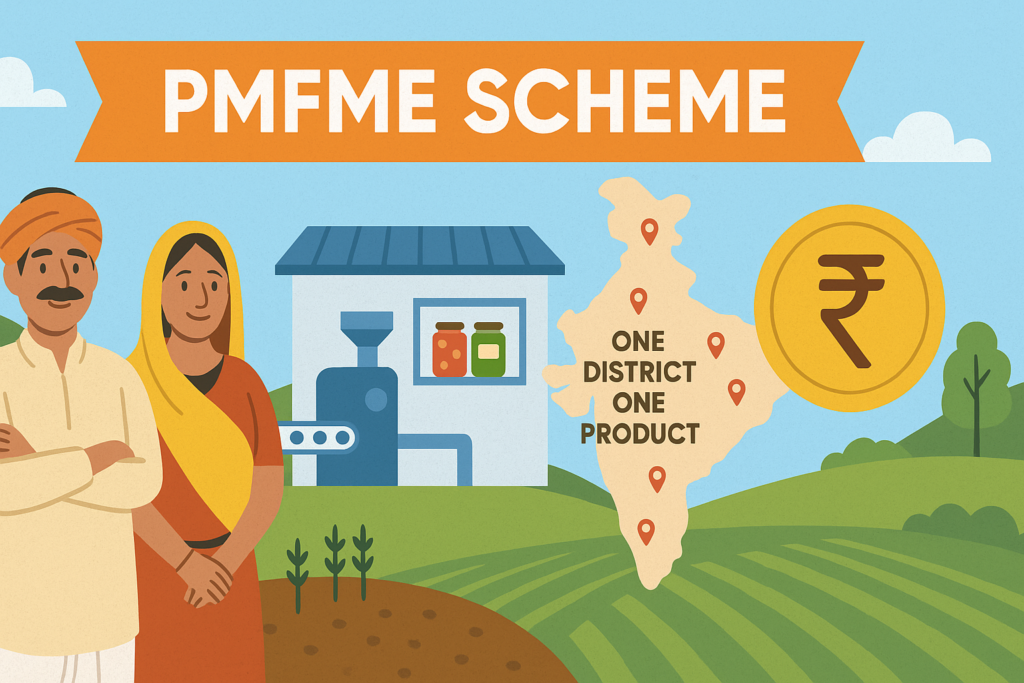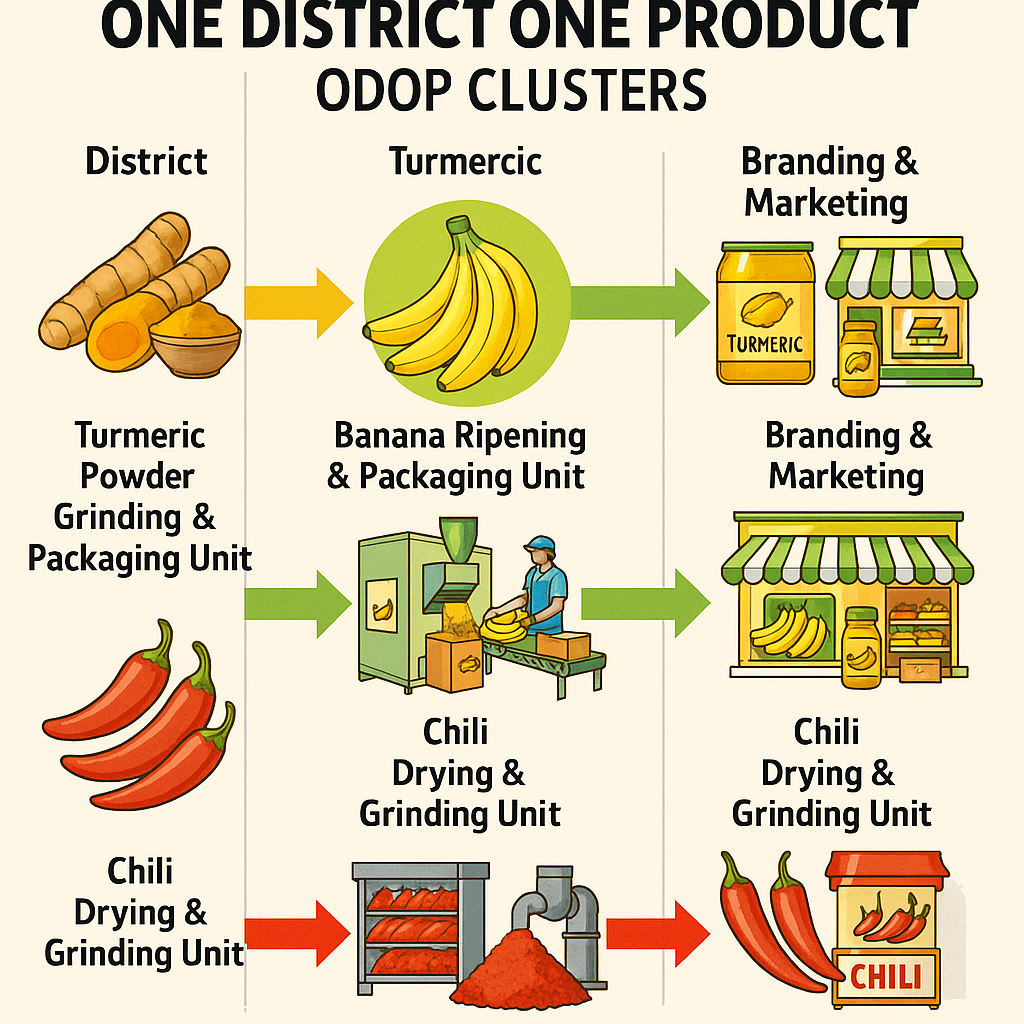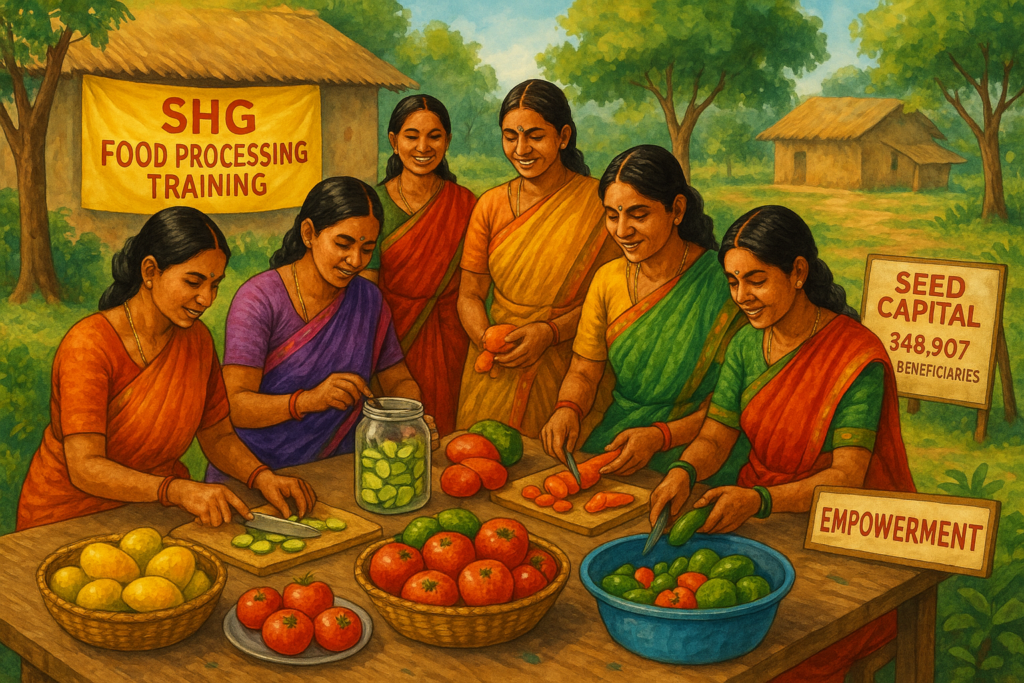
Key Highlights
- Massive Implementation Success: 1,44,517 loans sanctioned under credit-linked subsidy with ₹2,465.81 crore disbursed by June 2025, targeting 2 lakh micro enterprises across India’s unorganized food processing sector
- Women Empowerment Scale: 63,320 women entrepreneurs received credit-linked subsidies while 3,48,907 SHG members got seed capital support, demonstrating PMFME’s commitment to gender-inclusive rural development
- ODOP Cluster Success: One District One Product approach identifies specialty regional products with 760+ districts covered, creating focused value chains for items like Erode turmeric, Kozhikode banana, and Guntur chili
- Constitutional and SDG Alignment: Anchored in Article 43 (cottage industries) and Article 39(b) (equitable resource distribution), supporting SDG 2 (Zero Hunger), SDG 8 (Decent Work), and SDG 9 (Industry Innovation)
- Substantial Growth Trajectory: FY 2024-25 recorded 50,875 loans sanctioned compared to just 3,218 in FY 2021-22, showing exponential adoption with ₹1,142.6 crore center share released to states
The Unorganized Food Processing Challenge
India’s micro food processing sector comprises approximately 25 lakh units operating largely in the informal economy, representing 74% family-based enterprises that lack access to formal credit, technology, and markets. These micro-enterprises face multiple challenges including high institutional credit costs, limited modern technology access, food safety awareness gaps, and inadequate branding and marketing support. pib
The sector’s informal nature results in significant post-harvest losses (25-30%) and low value addition (less than 10%). Traditional food processors, street vendors, home-based units, and small-scale processors remain disconnected from organized supply chains, limiting their growth potential and income generation capabilities. mofpi
PMFME’s intervention addresses these structural challenges by providing credit-linked subsidies, common facility centers, skill development, and market linkage support to formalize operations and enhance competitiveness pmfme
Scheme Architecture: Credit-Linked Transformation Model
Financial Structure and Implementation
PMFME operates with a ₹10,000 crore outlay (2020-2025) following a credit-linked subsidy model providing 35% upfront subsidy on bank-sanctioned term loans up to ₹10 lakh per unit. The cost-sharing ratio follows 60:40 Centre-State for general states and 90:10 for Northeast/Himalayan states.
Implementation responsibility lies with the Ministry of Food Processing Industries (MoFPI) through State Nodal Agencies, ensuring decentralized execution while maintaining national standards. District-level committees approve individual enterprise applications while state-level committees handle group applications.
Multi-tiered governance includes National Project Management Units, State Project Management Units, and third-party monitoring for transparency and impact evaluation. This comprehensive structure ensures effective fund utilization and scheme objective achievement.
Component-wise Breakdown
Credit-Linked Subsidy forms the primary component, with ₹1,501.79 crore sanctioned for 1,44,517 individual enterprises including 49,035 general category, 12,361 SC, and 7,566 ST beneficiaries. Women entrepreneurs received 63,320 loans, highlighting the scheme’s inclusive approach.
Seed Capital Support reached 3,48,907 SHG members with ₹1,182.48 crore sanctioned, directly empowering rural women through collective entrepreneurship. Common Infrastructure component approved 93 projects worth ₹187.20 crore, while Branding & Marketing supported 27 initiatives with ₹82.82 crore. pib
ODOP Strategy: District-Specific Value Chain Development

Regional Specialization Framework
One District One Product (ODOP) approach leverages regional comparative advantages by focusing on district-specific specialty products. The strategy identifies over 1,000 products from 760+ districts, creating economies of scale in procurement, processing, and marketing.
Priority sectors include perishable commodities such as fruits, vegetables, spices, fisheries, and traditional foods like honey and turmeric. Capital investment prioritization for ODOP units ensures focused resource allocation while new enterprises qualify only for ODOP products.
Cluster-based initiatives complement the Agriculture Export Policy and Agriculture Ministry programs, creating stronger value chains and shared common facilities. Market linkage support through digital B2B platforms facilitates broader market access for district-specific products.
Success Stories and Impact
Ruby Fresh Snacks in Ernakulam, Kerala exemplifies PMFME’s transformative impact. Mr. P M Jaleel’s enterprise grew from ₹12,000 daily profits to ₹20,000 after receiving ₹3 lakh loan in 2021, with annual turnover exceeding ₹32 lakh by 2021-22.
Regional success patterns demonstrate ODOP’s effectiveness across diverse products and geographical contexts. Traditional food processors gain access to modern equipment, packaging facilities, and quality certification, enhancing product quality and market reach.
Value addition through ODOP clusters reduces post-harvest losses while increasing farmer incomes through better price realization and extended shelf life of processed products.
SHG and FPO Empowerment: Collective Entrepreneurship

Women-Led Rural Enterprise Development
Self-Help Group (SHG) empowerment represents a cornerstone of PMFME’s inclusive approach, with 3,48,907 women members receiving seed capital support totaling ₹1,182.48 crore. This massive scale demonstrates the scheme’s commitment to gender-inclusive rural development.
Capacity building initiatives include digital training on quality standards, e-commerce platforms, financial literacy, and bookkeeping support. SHG members gain access to Common Facility Centers, reducing capital investment requirements while sharing processing infrastructure.
Marketing linkage support connects SHG enterprises with retail chains, export markets, and digital platforms, expanding market reach beyond local boundaries. Collective bargaining power enables better input procurement and output pricing for SHG-led enterprises.
Farmer Producer Organization Integration
Farmer Producer Organizations (FPOs) receive comprehensive value chain support through PMFME, connecting primary production with processing and marketing. FPO integration ensures farmer ownership of value addition processes, maximizing income retention within farming communities.
Technical support includes processing technology access, quality control systems, and market intelligence, enabling FPOs to compete effectively in organized markets. Common facility sharing among FPO members reduces individual investment while maintaining processing quality.
Branding and marketing support following ODOP guidelines helps FPOs develop recognizable product identities and access premium market segments. Digital platform integration facilitates direct-to-consumer sales and B2B transactions.
Constitutional and Policy Alignment
Constitutional Foundation
PMFME’s legal foundation rests on Article 43 of the Constitution, which mandates promotion of cottage industries on individual or cooperative basis in rural areas. The scheme operationalizes constitutional directives by providing systematic support for micro-enterprise development.
Article 39(b) regarding equitable resource distribution finds practical expression through PMFME’s inclusive design, ensuring marginalized communities gain access to formal credit and business development support. SC/ST entrepreneurs received 19,927 loans, demonstrating social inclusion in economic development.
Directive Principles implementation through PMFME shows how constitutional mandates can be transformed into concrete policy interventions that directly benefit rural populations and traditional food processors.
SDG Alignment and Global Commitments
Sustainable Development Goal (SDG) alignment positions PMFME within global development frameworks. SDG 2 (Zero Hunger) benefits from reduced food wastage and enhanced food processing capabilities. Value addition through micro-enterprises improves food security by extending shelf life and nutritional accessibility.
SDG 8 (Decent Work and Economic Growth) receives direct support through job creation in rural areas and formalization of informal enterprises. Women entrepreneurship through SHG participation contributes to SDG 5 (Gender Equality) objectives.
SDG 9 (Industry, Innovation and Infrastructure) benefits from common facility centers, technology upgradation, and innovation support for micro-enterprises. Digital platform integration and modern processing equipment enhance industrial capabilities at grassroots level.
Scheme Integration and Synergies
Complementary Program Coordination
PMFME complements existing food processing initiatives including PM-Kisan SAMPADA Yojana for larger-scale projects and Agriculture Infrastructure Fund for storage and logistics. Synergistic implementation avoids duplication while maximizing resource utilization.
Integration with rural development programs ensures holistic support for agricultural value chains. MGNREGA linkages provide additional employment during infrastructure development, while skill development programs enhance workforce capabilities.
Digital India integration through online platforms and digital payment systems modernizes traditional food processing while maintaining cultural authenticity. Technology adoption improves efficiency without displacing traditional methods.
Atmanirbhar Bharat Contribution
PMFME’s role in Atmanirbhar Bharat extends beyond import substitution to export promotion and value chain strengthening. Indigenous food processing reduces dependence on processed food imports while creating export opportunities for traditional products.
Local sourcing emphasis through ODOP strengthens domestic supply chains and reduces transportation costs. Regional specialization creates competitive advantages in specific product categories while maintaining quality standards.
Innovation support through R&D partnerships and technology transfer enhances indigenous capabilities in food processing technology. Make in India objectives receive direct support through equipment manufacturing and technology development.
Challenges and Implementation Lessons
Credit Access and Awareness Issues
Low credit uptake remains a persistent challenge despite attractive subsidy provisions. Rural entrepreneurs often lack awareness about formal credit procedures and documentation requirements. PMFME addresses these challenges through credit facilitation camps and bank-MoFPI MoUs.
Financial literacy programs help micro-entrepreneurs understand loan procedures, subsidy mechanisms, and repayment schedules. Simplified documentation and digital application processes reduce bureaucratic barriers for rural applicants.
Awareness campaigns through mobile advisories, local media, and community outreach improve scheme visibility among target beneficiaries. Success story dissemination builds confidence among potential applicants.
Infrastructure and Supply Chain Constraints
Fragmented supply chains limit micro-enterprises’ ability to access inputs and reach markets. Cold storage gaps particularly affect perishable food processing, leading to quality deterioration and value loss.
Common Facility Centers address infrastructure constraints by providing shared processing equipment, cold storage, packaging facilities, and testing laboratories. Cluster-based development enables economies of scale in infrastructure investment.
Digital marketplace integration helps overcome geographical barriers and connects micro-enterprises with broader markets. Logistics support through public-private partnerships improves last-mile connectivity for rural processors.
Global Lessons and Best Practices
China’s Rural Food Cluster Model
China’s success in rural food processing clusters offers valuable lessons for PMFME implementation. Jiangsu’s noodle processing belt and Shandong’s fruit processing hubs demonstrate benefits of scale, skill development, and infrastructure sharing.
Key success factors include standardized quality control, strong public-private partnerships, continuous skill upgradation, and global market orientation. Technology transfer and innovation support create competitive advantages in international markets.
India’s adaptation of cluster models through ODOP incorporates Chinese lessons while respecting local contexts and traditional food cultures. Scaling strategies focus on gradual expansion rather than rapid transformation.
International Cooperation Opportunities
South-South cooperation enables knowledge sharing with other developing countries facing similar challenges in food processing development. Technical assistance programs and capacity building exchanges benefit multiple countries.
Export market development through international partnerships creates opportunities for Indian micro-enterprises to access global markets. Quality certification and compliance support enable export readiness for traditional products.
Future Outlook and Sustainability
Scheme Continuation and Expansion
Mid-term evaluation by third-party assessors recommends scheme continuation beyond 2025, recognizing significant achievements and continued relevance. Policy discussions focus on design improvements and coverage expansion based on implementation experience.
Technology integration will enhance efficiency through IoT applications, blockchain traceability, and AI-powered quality control. Digital transformation of micro-enterprises improves competitiveness while maintaining traditional authenticity.
Private sector participation through Public-Private Partnerships can leverage additional resources and expertise for scheme expansion. Corporate social responsibility initiatives align with PMFME objectives for mutual benefit.
Long-term Impact Projections
Employment generation projections indicate significant job creation in rural areas, particularly benefiting women and marginalized communities. Income enhancement through value addition contributes to doubling farmer income objectives.
Export potential for traditional Indian foods increases through quality improvement and international marketing support. Cultural preservation through traditional food processing maintains heritage while generating economic value.
Sustainable development through reduced food wastage, enhanced nutrition access, and rural industrialization positions PMFME as a transformative rural development intervention.
Conclusion
The Pradhan Mantri Formalisation of Micro Food Processing Enterprises (PMFME) Scheme represents a paradigm shift in India’s rural development approach, successfully formalizing over 1.44 lakh micro-enterprises with ₹2,465.81 crore in credit-linked subsidies by June 2025. This remarkable achievement demonstrates the scheme’s effectiveness in transforming informal food processors into competitive formal enterprises.
Women empowerment through PMFME reaches unprecedented scale, with 63,320 women entrepreneurs receiving credit support and 3.48 lakh SHG members benefiting from seed capital assistance. This gender-inclusive approach creates sustainable livelihoods while preserving traditional food processing knowledge and skills.
One District One Product (ODOP) strategy successfully leverages regional comparative advantages, creating focused value chains for specialty products across 760+ districts. Success stories like Ruby Fresh Snacks demonstrate how targeted support can transform small enterprises into thriving businesses with substantial income growth.
Constitutional alignment with Articles 43 and 39(b) provides solid legal foundation for cottage industry promotion and equitable resource distribution. SDG alignment positions PMFME within global development frameworks, contributing to zero hunger, decent work, and industrial innovation objectives.
Integration with Atmanirbhar Bharat objectives strengthens domestic food processing capabilities while reducing import dependence and creating export opportunities. Common Facility Centers and technology upgradation modernize traditional processing without losing cultural authenticity.
Implementation challenges including credit access barriers, supply chain fragmentation, and awareness gaps find systematic solutions through capacity building, digital platforms, and institutional coordination. Learning from global best practices, particularly China’s rural food clusters, informs scaling strategies and quality improvement initiatives.
Future sustainability requires scheme continuation beyond 2025, technology integration, and enhanced private sector participation. Mid-term evaluation recommendations provide roadmap for design improvements and coverage expansion based on field experience.
PMFME’s transformative impact extends beyond economic benefits to social empowerment, cultural preservation, and environmental sustainability. Reduced food wastage, enhanced nutrition access, and rural industrialization create multiple development benefits from single intervention.
The scheme’s success in formalizing India’s vast informal food processing sector provides a replicable model for other developing countries facing similar challenges. Comprehensive approach combining credit support, infrastructure development, skill building, and market linkages ensures holistic enterprise development.
PMFME stands as a testament to effective policy design and implementation, demonstrating how well-targeted government interventions can unlock entrepreneurial potential in rural areas while contributing to national economic objectives and global development goals.
📌 Mains Practice Questions
- “PMFME is a transformative step in decentralising India’s food processing ecosystem.” Discuss its role in rural industrialisation and inclusive growth.
- Examine the convergence of PMFME with agricultural and MSME policies to achieve Atmanirbhar Bharat goals.









+ There are no comments
Add yours